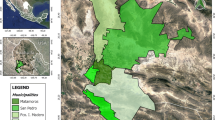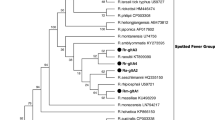Abstract
Rickettsia species are bacteria that may cause multiple diseases in animals and humans, via transmission through multiple arthropod vectors. Routine surveillance of Rickettsia spp. within vectors is critical to determine their presence and risk to mammalian hosts within human populations. Therefore, to better characterize the circulating Rickettsia species in an understudied region we targeted pet dogs to survey. Ticks were collected from pet dogs in three populations of the Yucatan where we tested for the presence of Rickettsia spp. by PCR in metagenomic DNA. In these ticks removed from pet dogs we detected Rickettsia amblyommatis and Rickettsia bellii in Amblyomma auriculatum, Amblyomma ovale and Amblyomma mixtum ticks obtained in a rural community in the Mexican state of Yucatan. This is the first report detecting both species for this state in Mexico, underpinning the importance of more routine surveillance.


Similar content being viewed by others
References
Alvarez-Hernandez G, Murillo-Benitez C, Candia-Plata Mdel C, Moro M (2015) Clinical profile and predictors of fatal Rocky Mountain spotted fever in children from Sonora, Mexico. Pediatr Infect Dis J 34(2):125–130. https://doi.org/10.1097/INF.0000000000000496
Alvarez-Hernandez G, Drexler N, Paddock CD, Licona-Enriquez JD, la Mora JD, Straily A, Del Carmen Candia-Plata M, Cruz-Loustaunau DI, Arteaga-Cardenas VA (2020) Community-based prevention of epidemic Rocky Mountain spotted fever among minority populations in Sonora, Mexico, using a one health approach. Trans R Soc Trop Med Hyg 114(4):293–300. https://doi.org/10.1093/trstmh/trz114
Álvarez-López DI, Ochoa-Mora E, Nichols Heitman K, Binder AM, Álvarez-Hernández G, Armstrong PA (2021) Epidemiology and clinical features of Rocky Mountain spotted fever from enhanced surveillance, Sonora, Mexico: 2015–2018. Am J Trop Med Hyg 104(1):190–197. https://doi.org/10.4269/ajtmh.20-0854
Arroyo-Ramírez A, Lugo-Caballero C, Bolio-González M, Rodríguez-Vivas RI, Reyes Novelo E, Panti-May JA, Torres-Castro M (2022) El género Rickettsia y reportes de infección en perros de Yucatán. Bioagrociencias 15(1):65–76
Bermúdez SE, Castillo E, Pohlenz TD, Kneubehl A, Krishnavajhala A, Domínguez L, Suárez A, López JE (2017) New records of Ornithodoros puertoricensis Fox 1947 (Ixodida: Argasidae) parasitizing humans in rural and urban dwellings, Panama. Ticks Tick Borne Dis 8(4):466–469. https://doi.org/10.1016/j.ttbdis.2017.02.004
Bermúdez SE, Félix ML, Domínguez AL, Kadoch N, Muñoz-Leal S, Venzal JM (2021) Molecular screening for tick-borne bacteria and hematozoa in Ixodes cf. boliviensis and Ixodes tapirus (Ixodida: Ixodidae) from western highlands of Panama. Curr Res Parasitol Vector Borne Dis 1:100034. https://doi.org/10.1016/j.crpvbd.2021.100034
Black WC, DuTeau NM (1997) RAPD-PCR and SSCP analysis for insect population genetic studies. In: Crampton JM, Beard CB, Louis C (eds) Molecular Biology of Insect Disease vectors: a Methods Manual. Chapman & Hall, London, pp 362–363
Black WC, Piesman J (1994) Phylogeny of hard- and soft-tick taxa (Acari: Ixodida) based on mitochondrial 16S rDNA sequences. Proc Natl Acad Sci USA 91(21):10034–10038. https://doi.org/10.1073/pnas.91.21.10034
Brinton EP, Beck DE (1963) Hard-bodied ticks of the Western United States. Part I. Brigh Young Univ Sci Bull 2(3):1–28
Buckingham SC, Marshall GS, Schutze GE, Woods CR, Jackson MA, Patterson LE, Jacobs RF (2007) Tick-borne infections in children Study Group. Clinical and laboratory features, hospital course, and outcome of Rocky Mountain spotted fever in children. J Pediatr 150(2):180–184. https://doi.org/10.1016/j.jpeds.2006.11.023
Caminade C, McIntyre KM, Jones AE (2019) Impact of recent and future climate change on vector-borne diseases. Ann NY Acad Sci 1436(1):157–173. https://doi.org/10.1111/nyas.13950
Charles RA, Bermúdez S, Banović P, Obregon D, Díaz-Sánchez AA, Corona-González B, Etter E, Rodríguez I, Ghafar A, Jabbar A, Moutailler S, Cabezas-Cruz A (2021) Ticks and Tick-Borne Diseases in Central America and the Caribbean: a One Health Perspective. Pathogens 10(10):1273. https://doi.org/10.3390/pathogens10101273
Cicuttin GL, De Salvo MN, Venzal JM, Nava S (2022) Rickettsia spp., Ehrlichia sp. and Candidatus Midichloria sp. associated to ticks from a protected urban area in Buenos Aires City (Argentina). Exp Appl Acarol 86:271–282. https://doi.org/10.1007/s10493-022-00684-0
Cortés JA (2010) Cambios en la distribución y abundancia de las garrapatas y su relación con el calentamiento global. Revista de la Facultad de Medicina Veterinaria y de Zootecnia 57(1):48–57
Delgado-de la Mora J, Sánchez-Montes S, Licona-Enríquez JD, Delgado-de la Mora D, Paddock CD, Beati L, Colunga-Salas P, Guzmán-Cornejo C, Zambrano ML, Karpathy SE, López-Pérez AM, Álvarez-Hernández G (2019) Rickettsia parkeri and Candidatus Rickettsia andeanae in Tick of the Amblyomma maculatum Group, Mexico. Emerg Infect Dis 25(4):836–838. https://doi.org/10.3201/eid2504.181507
Dirección General de Epidemiología, Sistema Epidemiológico y Estadístico de las Defunciones 2021 (SEED), Secretaría de Salud
Guo X, Xia X, Tang R (2008) Real-time PCR quantification of the predominant bacterial divisions in the distal gut of Meishan and Landrace pigs. Anaerobe 14(4):224–228. https://doi.org/10.1016/j.anaerobe.2008.04.001
Guzmán-Cornejo C, Robbins RG, Guglielmone AA, Montiel-Parra G, Pérez TM (2011) The Amblyomma (Acari: Ixodida: Ixodidae) of Mexico: Identification Keys. Distribution and Hosts Zootaxa 2998(1):16–38. https://doi.org/10.11646/zootaxa.2998.1.2
Karpathy SE, Slater KS, Goldsmith CS, Nicholson WL, Paddock CD (2016) Rickettsia amblyommatis sp. nov., a spotted fever group Rickettsia associated with multiple species of Amblyomma ticks in North, Central and South America. Int J Syst Evol Microbiol 66(12):5236–5243. https://doi.org/10.1099/ijsem.0.001502
Keirans JE, Litwak TR (1989) Pictorial key to the adults of hard ticks, family Ixodidae (Ixodida: Ixodoidea), east of the Mississippi river. J Med Entomol 26(5):435–448. https://doi.org/10.1093/jmedent/26.5.435
Labruna MB, Whitworth T, Horta MC, Bouyer DH, McBride JW, Pinter A, Popov V, Gennari SM, Walker DH (2004) Rickettsia species infecting Amblyomma cooperi ticks from an area in the state of São Paulo, Brazil, where brazilian spotted fever is endemic. J Clin Microbiol 42(1):90–98. https://doi.org/10.1128/JCM.42.1.90-98.2004
Labruna MB, Pacheco RC, Nava S, Brandão PE, Richtzenhain LJ, Guglielmone AA (2007) Infection by Rickettsia bellii and Candidatus “Rickettsia amblyommii” in Amblyomma neumanni ticks from Argentina. Microb Ecol 54(1):126–133. https://doi.org/10.1007/s00248-006-9180-3
Laukaitis HJ, Macaluso KR (2021) Unpacking the intricacies of Rickettsia-vector interactions. Trends Parasitol 37(8):734–746. https://doi.org/10.1016/j.pt.2021.05.008
Lugo-Caballero C, Torres-Castro M, López-Ávila K, Hernández-Betancourt S, Noh-Pech H, Tello-Martín R, Puerto-Manzano F, Dzul-Rosado K (2021) Molecular identification of zoonotic Rickettsia species closely related to R. typhi, R. felis, & R. rickettsii in bats from Mexico. Indian J Med Res 154(3):536–538. https://doi.org/10.4103/ijmr.IJMR_1083_19
Martínez-Ortiz D, Torres-Castro M, Koyoc-Cardeña E, López K, Panti-May A, Rodríguez-Vivas I, Puc A, Dzul K, Zavala-Castro J, Medina-Barreiro A, Chablé-Santos J, Manrique-Saide P (2016) Molecular evidence of Rickettsia typhi infection in dogs from a rural community in Yucatán. México Biomed 36(0):45–50. https://doi.org/10.7705/biomedica.v36i2.2913
Martínez-Ortiz D, Torres-Castro M, López-Ávila K, Koyoc-Cardeña E, Manrique-Saide P (2019) Rickettsia spp. en garrapatas (Acari: Ixodidae) que infestan perros de una comunidad rural con antecedentes de rickettsiosis, Yucatán, México. Biomédica 30(2). https://www.revistabiomedica.mx/index.php/revbiomed/article/view/650/678
Mastropaolo M, Tarragona EL, Silaghi C, Pfister K, Thiel C, Nava S (2016) High prevalence of “Candidatus Rickettsia amblyommii’ in Amblyomma ticks from a spotted fever endemic region in north Argentina. Comp Immunol Microbiol Infect Dis 46:73–76. https://doi.org/10.1016/j.cimid.2016.05.001
Medina A, Guevara E, Alcantara V, Garza C, Hunt F, Davis J, Gonzalez R, Bouyer D, Walker D (2007) Isolation of Rickettsia amblyommii and seroprevalence of Rickettsia in the state of Veracruz, Mexico. Abstract #132. 21st Meeting of the American Society for Rickettsiology; Colorado Springs, CO
Merino O, De la Cruz NI, Martinez J, Pérez de León AA, Romero-Salas D, Esteve-Gassent MD, Lagunes-Quintanilla R (2020) Molecular detection of Rickettsia species in ticks collected in the Mexico-USA transboundary region. Exp Appl Acarol 80(4):559–567. https://doi.org/10.1007/s10493-020-00483-5
Miranda RJ, Mattar VS, González TM (2017) Rickettsiosis. Revista MVZ Córdoba 22(supl) 6118–6133. https://doi.org/10.21897/rmvz.1080
Nogueira Angerami R, Oliveira Morais E, Katz G, Jacintho da Silva L (2009) Brazilian spotted fever in the paediatric age-segment in the state of São Paulo, southeastern Brazil, 2003–2006. Clin Microbiol Infect 15(Suppl 2):205–206. https://doi.org/10.1111/j.1469-0691.2008.02728.x
Ogata H, La Scola B, Audic S, Renesto P, Blanc G, Robert C, Fournier PE, Claverie JM, Raoult D (2006) Genome sequence of Rickettsia bellii illuminates the role of Amoebae in gene exchanges between intracellular pathogens. PLoS Genet 2(5):e76. https://doi.org/10.1371/journal.pgen.0020076
Ortuño A, Pons I, Nogueras MM, Castellà J, Segura F (2009) The dog as an epidemiological marker of Rickettsia conorii infection. Clin Microbiol Infect 15 Suppl 2:241–242. https://doi.org/10.1111/j.1469-0691.2008.02158.x
Peniche-Lara G, Lara-Perera V (2022) Rickettsiosis caused by Rickettsia parkeri, Mexico. Emerg Infect Dis 28(2):478–479. https://doi.org/10.3201/eid2802.210454
Peniche-Lara G, Dzul-Rosado K, Jiménez-Delgadillo B, Vado-Solís I, Pérez-Osorio C, Zavala-Castro J (2014) Identificación de Rickettsia spp. en garrapatas Amblyomma cajennense parasitando bovinos en ranchos del estado de Yucatán. Ciencia y Humanismo en la Salud 1(1):23–27
Peniche-Lara G, Dzul-Rosado K, Pérez-Osorio C, Zavala-Castro J (2015) Rickettsia typhi in rodents and R. felis in fleas in Yucatán as a possible causal agent of undefined febrile cases. Rev Inst Med Trop Sao Paulo 57(2):129–132. https://doi.org/10.1590/S0036-46652015000200005
Peniche-Lara G, Jimenez-Delgadillo B, Munoz-Zanzi C, Cárdenas-Marrufo M, Pérez-Osorio C, Arias-León J (2018) Presence of Rickettsia Species in a Marginalized Area of Yucatan, Mexico. J Trop Med. 2018:7675828. https://doi.org/10.1155/2018/7675828
Premaratna R (2022) Rickettsial illnesses, a leading cause of acute febrile illness. Clin Med (Lond) 22(1):2–5. https://doi.org/10.7861/clinmed.2021-0790
Richardson EA, Roe RM, Apperson CS, Ponnusamy L (2023) Rickettsia amblyommatis in Ticks: a review of distribution, pathogenicity, and Diversity. Microorganisms 11(2):493. https://doi.org/10.3390/microorganisms11020493
Rodríguez Vivas RI, Ojeda Chi M, Bolio González M, Rosado Aguilar JA (2019) Las garrapatas como vectores de enfermedades zoonóticas en México. Bioagrociencias 12(1):19–26
Salceda-Sánchez B, Gasca-Zarate CM, Jiménez-Soto K, Grostieta E, López-Sánchez CG, Soto-Gutiérrez JJ, Lammoglia-Villagómez MA, Huerta-Peña J, Hernández-Carbajal GR, Chagoya-Fuentes JL, Jácome-Sosa E, Pérez-Brígido CD, Ballados-González GG, Becker I, Sánchez-Montes S (2023) Molecular detection of Rickettsia felis in fleas and ticks collected from dogs and cats of Puebla, Mexico. Zoonoses Public Health 70(2):176–183. https://doi.org/10.1111/zph.13011
Salomon J, Fernandez Santos NA, Zecca IB, Estrada-Franco JG, Davila E, Hamer GL, Rodríguez Pérez MA, Hamer SA (2022) Brown Dog Tick (Rhipicephalus sanguineus Sensu Lato) infection with endosymbiont and human pathogenic Rickettsia spp., in northeastern México. Int J Environ Res Public Health 19(10):6249. https://doi.org/10.3390/ijerph19106249
Sánchez-Montes S, Colunga-Salas P, Lozano-Sardaneta YN, Zazueta-Islas HM, Ballados-González GG, Salceda-Sánchez B, Huerta-Jiménez H, Torres-Castro M, Panti-May JA, Peniche-Lara G, Muñoz-García CI, Rendón-Franco E, Ojeda-Chi MM, Rodríguez-Vivas RI, Zavala-Castro J, Dzul-Rosado K, Lugo-Caballero C, Alcántara-Rodríguez VE, Delgado-de la Mora J, Licona-Enríquez JD, Delgado-, de la Mora D, López-Pérez AM, Álvarez-Hernández G, Tinoco-Gracia L, Rodríguez-Lomelí M, Ulloa-García A, Blum-Domínguez S, Tamay-Segovia P, Aguilar-Tipacamú G, Cruz-Romero A, Romero-Salas D, Martínez-Medina MA, Becker I (2021) The genus Rickettsia in Mexico: Current knowledge and perspectives. Ticks Tick Borne Dis 12(2):101633. https://doi.org/10.1016/j.ttbdis.2020.101633
Sebastian PS, Winter M, Abate SD, Tarragona EL, Nava S (2022) Molecular detection of Candidatus Rickettsia andeanae and Ehrlichia sp. in Amblyomma pseudoconcolor Aragão, 1908 (Acari: Ixodidae) from the argentinian Patagonia. Animals 12(23):3307. https://doi.org/10.3390/ani12233307
Snellgrove AN, Krapiunaya I, Scott P, Levin ML (2021) Assessment of the pathogenicity of Rickettsia amblyommatis, Rickettsia bellii, and Rickettsia montanensis in a Guinea Pig Model. Vector Borne Zoonotic Dis 21(4):232–241. https://doi.org/10.1089/vbz.2020.2695
Swei A, Couper LI, Coffey LL, Kapan D, Bennett S (2020) Patterns, drivers, and Challenges of Vector-Borne Disease Emergence. Vector Borne Zoonotic Dis 20(3):159–170. https://doi.org/10.1089/vbz.2018.2432
Tamura K, Stecher G, Kumar S (2021) MEGA11: Molecular Evolutionary Genetics Analysis Version 11. Mol Biol Evol 38(7):3022–3027. https://doi.org/10.1093/molbev/msab120
Torres-Castro M, Reyes-Novelo E, Noh-Pech H, Sánchez-Montes S, Colunga-Salas P, Lugo-Caballero C, Rodríguez-Vivas RI (2022a) Rickettsia rickettsii and Rickettsia typhi in inhabitants from a rural community of southeast Mexico. Rev Peru Med Exp Salud Publica. 39(1):124–125. https://doi.org/10.17843/rpmesp.2022.391.10519
Torres-Castro M, Reyes-Novelo E, Bolio-González M, Lugo-Caballero C, Dzul-Rosado K, Colunga-Salas P, Sánchez-Montes S, Noh-Pech H, Puerto FI, Rodríguez-Vivas RI (2022b) Epidemiological study of the occurrence of Typhus Group Rickettsia Natural infection in Domiciliated Dogs from a Rural Community in South-Eastern Mexico. Anim (Basel) 12(20):2885. https://doi.org/10.3390/ani12202885
Ulloa-García A, Dzul-Rosado K, Bermúdez-Castillero SE, López-López N, Torres-Monzón JA (2020) Detección de Rickettsia typhi en Rhipicephalus sanguineus s.l. y Amblyomma mixtum en el sur de México [Detection of Rickettsia typhi in Rhipicephalus sanguineus s.l. and Amblyomma mixtum in South of Mexico]. Salud Publica Mex. 62(4):358–363. https://doi.org/10.21149/10160. PMID: 32549080
Yen WY, Stern K, Mishra S, Helminiak L, Sanchez-Vicente S, Kim HK (2021) Virulence potential of Rickettsia amblyommatis for spotted fever pathogenesis in mice. Pathog Dis 79(5):ftab024. https://doi.org/10.1093/femspd/ftab024
Acknowledgements
We would like to thank the owners of the dogs and their families for their support and permission to check their beloved pets. We also would like to thank members of our respective laboratories for their invaluable support. Specially to Javier Solís, Jose Hernández, and Sofía Luna (Laboratorio de Genética Microbiana at ENCB), and Martha Guadalupe Zacarias Pérez (Universidad Autónoma de Yucatán). We are also in great debt to both reviewers for all their critical comments and suggestions.
Funding
This work was supported by Secretaría de Investigación y Posgrado del Instituto Politécnico Nacional (SIP-IPN) (grant numbers 2022 − 0679 and 2023 − 0850).
Author information
Authors and Affiliations
Contributions
Conceptualization: JAI, GCR-S, EV-G; Methodology: EV-G, GCR-S, AEC-R, CM-W, ML-G, PE-DLS, GA-H; Formal analysis and investigation: JAI, GCR-S, EV-G, GA-H; Writing - original draft preparation: JAI, EV-G, GCR-S; Funding acquisition: JAI, GCR-S; Resources: EV-G, GCR-S, AEC-R, CM-W, ML-G, PE-DLS, GA-H; Software: PE-DLS; Supervision: JAI, GCR-S, GA-H; Validation: PE-DLS, GA-H, ML-G; Visualization: JAI, GCR-S, EV-G; Writing - review and editing: EV-G, GCR-S, AEC-R, CM-W, ML-G, PE-DLS, GA-H, JAI.
Corresponding authors
Ethics declarations
Competing interests
The authors have no relevant financial or non-financial interests to disclose.
Additional information
Publisher’s Note
Springer Nature remains neutral with regard to jurisdictional claims in published maps and institutional affiliations.
Rights and permissions
Springer Nature or its licensor (e.g. a society or other partner) holds exclusive rights to this article under a publishing agreement with the author(s) or other rightsholder(s); author self-archiving of the accepted manuscript version of this article is solely governed by the terms of such publishing agreement and applicable law.
About this article
Cite this article
Vázquez-Guerrero, E., Reyes-Solís, G.C., Cano-Ravell, A.E. et al. Detection of Rickettsia amblyommatis and Rickettsia bellii in ticks collected from pet dogs in peri-urban and rural areas in Yucatan, Mexico. Exp Appl Acarol 90, 441–453 (2023). https://doi.org/10.1007/s10493-023-00825-z
Received:
Accepted:
Published:
Issue Date:
DOI: https://doi.org/10.1007/s10493-023-00825-z




